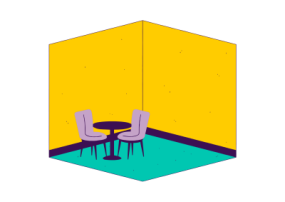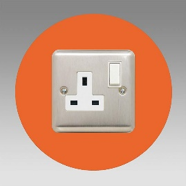In our latest article, Sight Scotland Veterans Lead Rehabilitation Officer Sandra Taylor shares her 5 tips to creating a dementia and sight loss-friendly home.


Consider how both conditions can impact each other
Dementia can cause changes in a person’s perception of the world around them. If that person also has sight loss, it further complicates the visual world and environment.
This can cause confusion and distress, so it's important to consider both things when thinking about decorating inside the home.

Avoid shiny surfaces
Shiny or reflective surfaces on walls, floors or tabletops can cause confusion as they can create glare and shadows.
These shadows can appear as holes or barriers to those with dementia and sight loss, resulting in some people refusing to pass or go near them, and causing fear and anxiety. Opting for matte finishes can make a big difference.

Keep floors and walls pattern-free
Busy patterns can be misinterpreted - for example, stripes and swirls can sometimes appear to be moving, and dots or small shapes may be interpreted as dirt or insects, which can again cause confusion and fear, as well as difficulty in navigating around spaces and moving around the environment.
Keep things plain instead, with good colour contrast.

Add photos or tactile markers to identify items
To help someone with dementia find the things they use often, it helps to add large, easy-to-see pictures on the outside of doors or drawers to identify what’s inside. For example, put a picture of a toilet on the bathroom door, or put a picture of a mug on a kitchen cabinet.
If a person's visual impairment prevents them from seeing photos at all, you could use tactile markers to identify different rooms - just remember to prioritise which items are labelled, as too many could add to confusion.

Use contrasting colours to highlight
Careful use of contrasting colour also helps with sight loss as well as dementia. For example, a dark plate on a light table makes it easier at meal times as the plate stands out from the table. A coloured non-slip mat below the plate can also help, or a plate that contrasts against the food.
Using the toilet can be quite a challenge because most bathrooms have light coloured floors, walls and toilet. That can make it tough for someone with dementia and sight loss to find the actual toilet and could cause them to accidentally go somewhere else, like a wastebasket or bath. Changing the toilet seat to a coloured one makes it easier to quickly see where the toilet bowl is. Coloured hand rails in contrasting colour can also be very helpful.
Other suggestions
Use textured or coloured stickers on large glass areas

Using colour contrasting stickers around light switches

Additional support
We hope these tips help, but if you need additional support either for yourself or someone you know who is experiencing sight loss, then our dedicated support team are there to help.
Visit our Get Support pages for more information, or call us today on 0800 024 8973.
You may also be interested in
Five things to know about lighting for visual impairments and sight loss
In our latest blog, Sight Scotland Veterans Lead Rehabilitation Officer, Sandra Taylor, shares five key things to know about lighting for those with visual impairment (VI).
Five things to know about communicating with people with visual impairments
Sight Scotland Veterans Senior Rehabilitation Officer, Fiona McCormick, shares five key things to know about communicating with someone with a visual impairment.
Dementia and Sight Loss Guide
Download Sight Scotland's guide on activities and care for people living with dementia and sight loss.